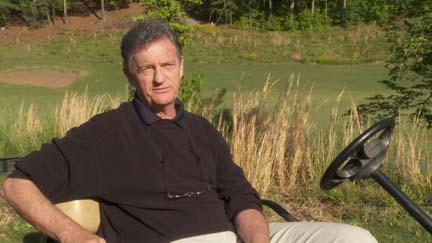 There are early adopters, and then there is Mark Hoban.
There are early adopters, and then there is Mark Hoban.The 60-year-old Hoban has been incorporating use of native grasses in Georgia and combating the Augusta Syndrome long before many knew that the title referred to manicured conditions and not a science fiction movie. And he has been seeking a look that reflects the game's classic era through going brown, saving on water use and reducing labor costs years before such things were chic in golf.
Hoban first adopted the brown look at The Standard Club in the mid-1970s, and has since put into practice at Rivermont Country Club when he arrived there 10 years ago. For his ability to convince others that brown is the new green and for his work at researching organic products, including his own homebrewed compost tea, Hoban has been named a finalist for the 2014 TurfNet Superintendent of the Year Award, presented by Syngenta.
"Mark Hoban has been and continues to be a pioneer in our industry when it comes to sustainable turf practices," wrote Rivermont general manager and owner Chris Cupit in nomination letter.
 "Over the years, Mark has converted almost 15 percent of our old golf course (25 of 188 acres) to very low maintenance native grasses and sedges that have become thriving habitats and food sources for our wild life near the river."
"Over the years, Mark has converted almost 15 percent of our old golf course (25 of 188 acres) to very low maintenance native grasses and sedges that have become thriving habitats and food sources for our wild life near the river."A total of 10 finalists have been chosen by a panel of judges from a field of nominees based on the following criteria: labor management, maximizing budget limitations, educating and advancing the careers of colleagues and assistants, negotiating with government agencies, preparing for tournaments under unusual circumstances, service to golf clientele, upgrading or renovating the course and dealing with extreme or emergency conditions.
The winner will be named Feb. 26 at the Golf Industry Show in San Antonio. Previous winners include: Chad Mark (2013); Dan Meersman (2012); Paul Carter, CGCS (2011); Thomas Bastis, CGCS (2010); Anthony Williams, CGCS (2009); Sam MacKenzie (2008); John Zimmers (2007); Scott Ramsay, CGCS (2006); Mark Burchfield (2005); Stuart Leventhal, CGCS (2004); Paul Voykin (2003); Jeff Burgess (2002); Kip Tyler (2001); and Kent McCutcheon (2000).
Hoban recently was named winner of the Georgia Golf Environmental Foundation Environmental Leader of the Year Award. His work incorporating native tall grasses, native sand and organic management practices that have helped put Rivermont on a path toward sustainability were the subject of a recent three-part TurfNet TV video series produced by Randy Wilson.
Hoban also has reduced fertilizer and fungicide use by embracing organic management practices. He maintains a worm bed on the property and brews compost tea that helps produce beneficial mychorrhizae in the soil, which is the subject of University of Georgia research being conducted on the course.
"It was actually Randy (Wilson) who pushed me out of the plane on organics," Hoban said. "He's the one who told me I could make an even bigger impact with that than what I've been doing with native grasses."
Although some superintendents have been slow to incorporate widespread use of organics, many also are lining up to see the results of the UGA research being conducted at Rivermont.
"Mark currently utilizes a red wiggler worm farm fed from our club's kitchen scraps to feed his vermiculture program. He has two compost tea brewers creating brews that include both thermal and vermicompost on our tees and fairway while the compost tea from the worm farm is used on our greens, tees and fairways," Cupit said.
"By using 100 percent reclaimed water, dramatically dropping his fungicide and nitrogen use through his organic approach and wholeheartedly embracing a more sustainable approach to golf course care, Mark has positioned our club to be well ahead of the game at a time when increased pressure is being applied to golf courses regarding their inputs."
One thing that surprises Hoban about his use of native grasses is why more low-budget courses haven't followed his lead.
"It's not about spending money," he said. "It's about spending your money more wisely, and doing something that doesn't cost a lot of money to set yourself apart from your competition."
Hoban began his career in 1971 at The Standard Club, where he eventually succeeded Palmer Maples Jr. in 1976, and began working with native grasses when the club physically moved from its original location in Brookhaven, Georgia to its current home in Johns Creek. His work there drew mixed reviews from golfers. Some loved it while others, obsessed with the idea of lost golf balls, hated it. But the use of native grasses, organics, implementation of butterfly-friendly zones and habitat for native bees all have been a sure-fire hit at Rivermont.
"People love the look of the native grasses, but they are ball magnets. That's the only problem," Hoban said.
"Bringing the native look to Georgia; I guess that is what I'm noted for, or condemned for."

